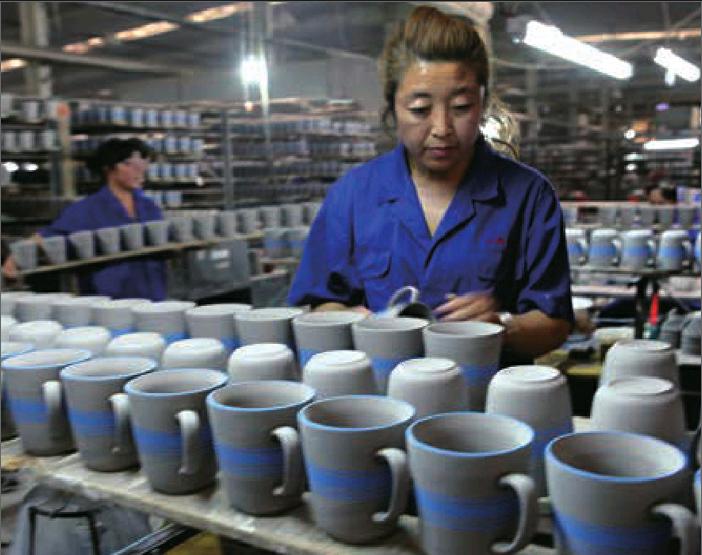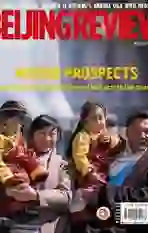The Lose-Lose Game
2017-04-13ByLanXinzhen
By+Lan+Xinzhen

The United States released on March 1 its 2017 Trade Policy Agenda and 2016 Annual Report of the President of the United States on the Trade Agreements Program. The document says Chinas entry into the World Trade Organiz ation (WTO) has undermined U.S. economic benefi ts, and the United States will reduce its dependence on the WTO trade dispute settlement mechanism by shifting from multilateral to bilateral mechanisms.
Astonishingly, this is from a country that was once a major proponent of globalization. The United States has not only turned to trade protectionism, but has also pointed its sword at China.
The truth about China In the WTO
Has the United States really suffered from Chinas entry into the WTO? No. As Chinas Ministry of Commerce (MOFCOM) spokesperson Sun Jiwen has said, Sino-U.S. economic and trade relations are mutually beneficial, and since the two countries established diplomatic ties, these relations have made remarkable progress and brought real benefi ts to their peoples.
In the past decade, U.S. cargo exports to China grew 11 percent annually on average; from 2001 to 2016, service exports from the United States to China grew 1,500 percent, marking a surplus increase of 2,900 percent.
According to statistics from the U.S.-China Business Council (USCBC), the bilateral trade sustains 2.6 million jobs in the United States, which contributes to the overall wellbeing of U.S. citizens.
In the realm of investment too, the United States has harvested huge profits from the bilateral relationship. MOFCOM statistics show by the end of 2016 Chinese enterprises non-fi nancial direct investment in the United States had reached $50 billion, scattered in 44 states and providing roughly 100,000 jobs. Investment in China has also brought huge profits for U.S. enterprises. According to a report on Chinas business environment released by the USCBC in October 2016, 90 percent of U.S. companies in China are in the black.
Instead of protecting its own trade benefits, the United States is trying to find an excuse for the new government to pursue trade protectionism. The report is testimony to the fact that the U.S. Government doesnt have a rational long-term plan to solve its economic problems and is bad at tackling problems that come up in the process of globalization.
In fact, the current problems the United States faces have their root in an inclination to the virtual economy, which is not caused by China but is a result of the global dollar policy. The United States has raked in money by printing banknotes and through other fi -nancial activities that have desolated the real economy and jacked up local labor costs. At the same time, Chinas opening up and reform as well as cheap labor and huge market attracted hordes of U.S. enterprises. Even if China hadnt opened its door, these enterprises would have gone to other developing countries.
Commitments kept
The United States kept putting pressure on the Chinese Government to open up its market to the outside world. To become more integrated with globalization efforts, China applied to resume its status as a contracting party to the General Agreement on Tariffs and Trade—the WTOs predecessor—in 1986, and carried out reform of its stateowned enterprises in the 1980s. This was implemented at the expense of large numbers of laid-off workers.
To enter the WTO, China faced tremendous hurdles from farm products imported from countries like the United States. The practice of using surrogate countries in antidumping claims against China—d e s i g n e d t o p r o t e c t t h e interests of companies in Western countries—was extended from fi ve to 15 years. In short, China has made big concessions to join the WTO.
In accordance with the WTO accession protocol, China further opened its market and cut tariffs following its entry in 2001. A number of U.S. companies investing in China have since made profi ts.
In terms of the China-U.S. trade relationship, U.S. trade deficits should be blamed on Washingtons own ideology. In the map of international industrial distribution, China tends to offer low value-added products and products processed from imported materials. The United States has hi-tech products to offer. However, in reality, using the excuse of ensuring its own security, the United States has set up trade barriers, compared to Chinas openness in its exports to the United States. As a result, Washington has witnessed a trade deficit. Beijing can obtain the products the United States has restricted from other countries. Without U.S. restrictions based on ideologies, it is China that would face a trade defi cit.
Globalization is now an irreversible historic trend. The U.S. decision to reduce its reliance on the WTO dispute settlement mechanism shows it is poised to turn a blind eye to WTO rulings that go against it. Multilateral trade systems, represented by the WTO, provide sound guarantees for the orderly and stable development of global trade. In the past 70 years or so, multilateral trade systems have helped make international trade freer and more convenient. Particularly during the fi nancial crisis, these systems played a crucial role in curbing trade protectionism and promoting global economic recovery by effectively monitoring members trade policy trends and settling trade disputes.
China holds an open attitude to the outside world. In his Report on the Work of the Government tabled at the annual session of the National Peoples Congress on March 5, Premier Li Keqiang stressed that China needs to provide a more investment-friendly environment for foreign investors and help liberalize and facilitate international trade and investment. The report also indicates an important task for the government this year is to amend the Catalogue of Industries for Guiding Foreign Investment to relax control over foreign investment in sectors such as services, manufacturing and mining.
Foreign investors will be supported to issue bonds, list in Chinas stock exchanges and participate in Chinas science and technology programs. Foreign companies will enjoy the same treatment as their Chinese counterparts under the Made in China 2025 strategy. Also, they can participate in public tenders on an equal footing with domestic enterprises.
In addition, the report says China will unswervingly push forward global economic cooperation, safeguard multilateral trade systems status and participate in multilateral trade negotiations.
The United States says it will safeguard fair trade. However, if trade protectionism is practiced under the guise of fair trade, both sides involved will get hurt. If members choose to flout WTO rules for the sake of their individual interests, refusing to implement WTO rulings to settle disputes, the multilateral trade system will fall apart. In the worst-case scenario, the trade war of the 1930s might recur and history has proved that trade wars can only lead to both sides losing.
